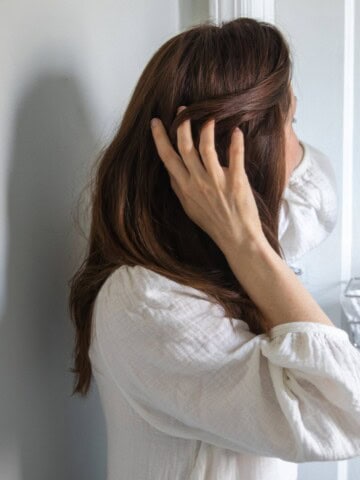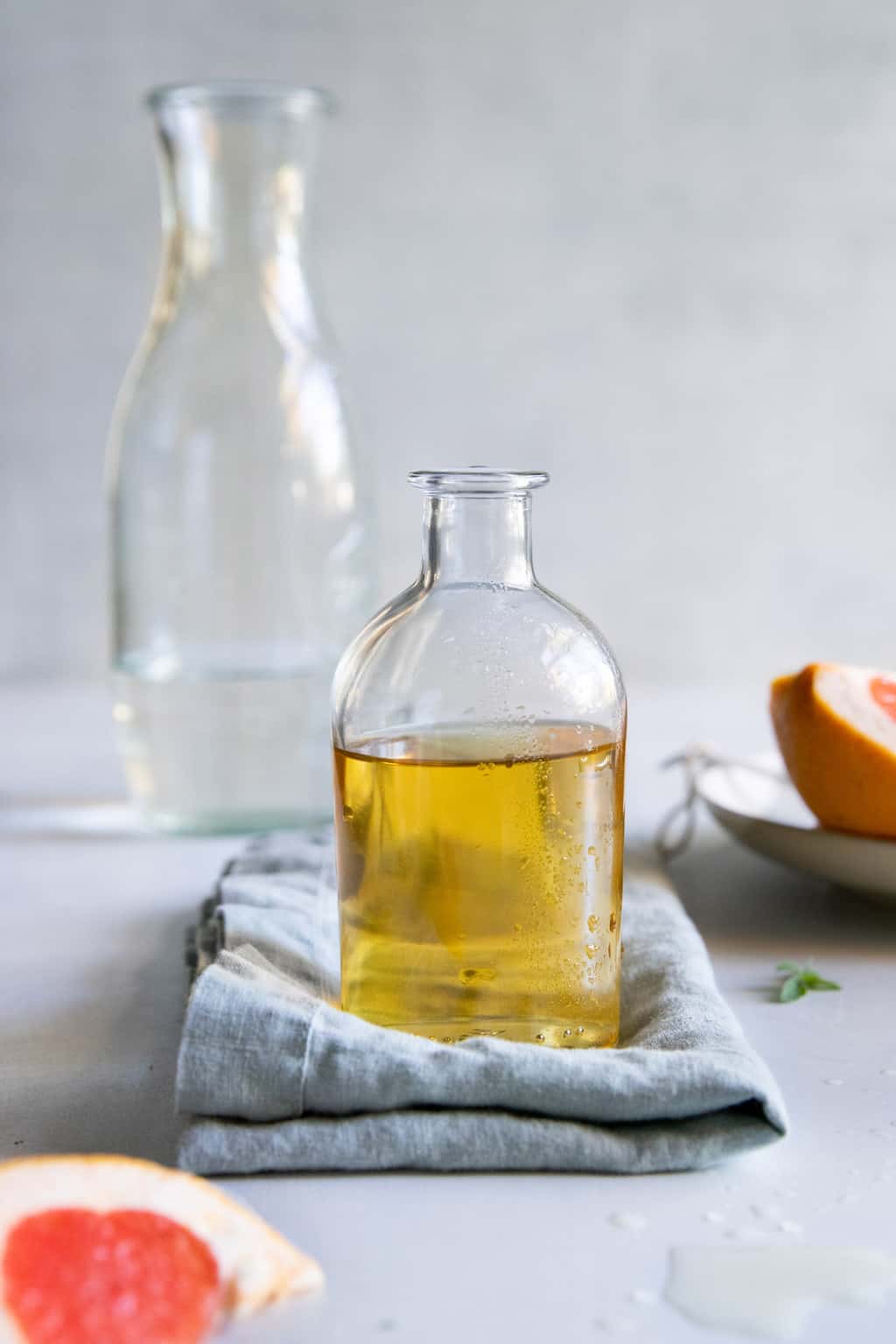Why is it that straight-haired ladies always want curls while curly gals want their hair straightened? Blondes want to be redheads, and brunettes want to be blondes. But one thing that all women can (generally) agree on is that healthy hair looks best! Whatever ails you about your tresses, you can find a remedy with a homemade hair rinse. Scroll through for some easy DIY recipes:
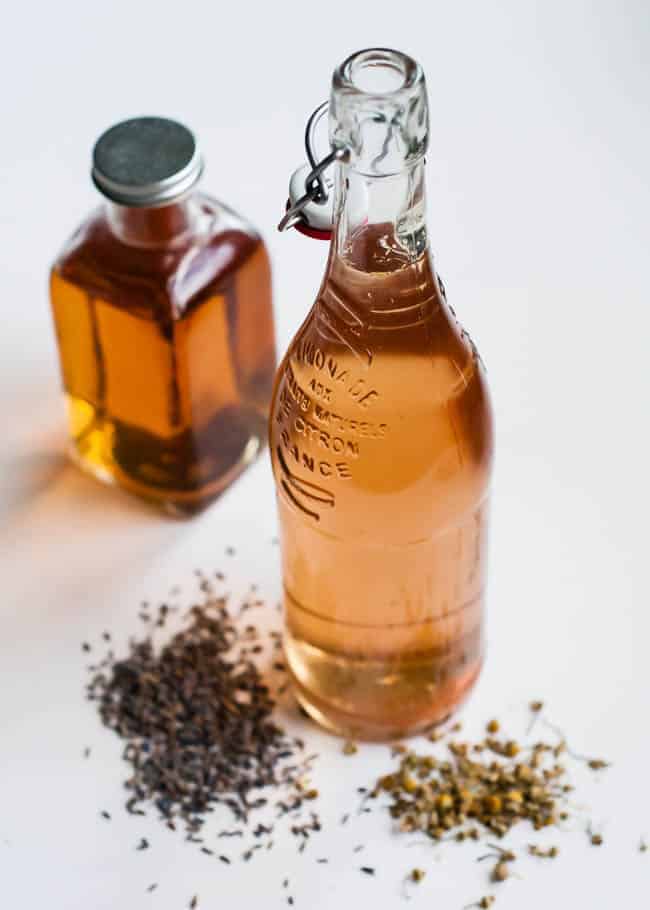
Making an herbal hair rinse at home is a simple and effective way to nurture your hair using natural ingredients. Here’s a general guide on how to make one, with a few variations based on different hair needs:
Jump to:
Basic Ingredients
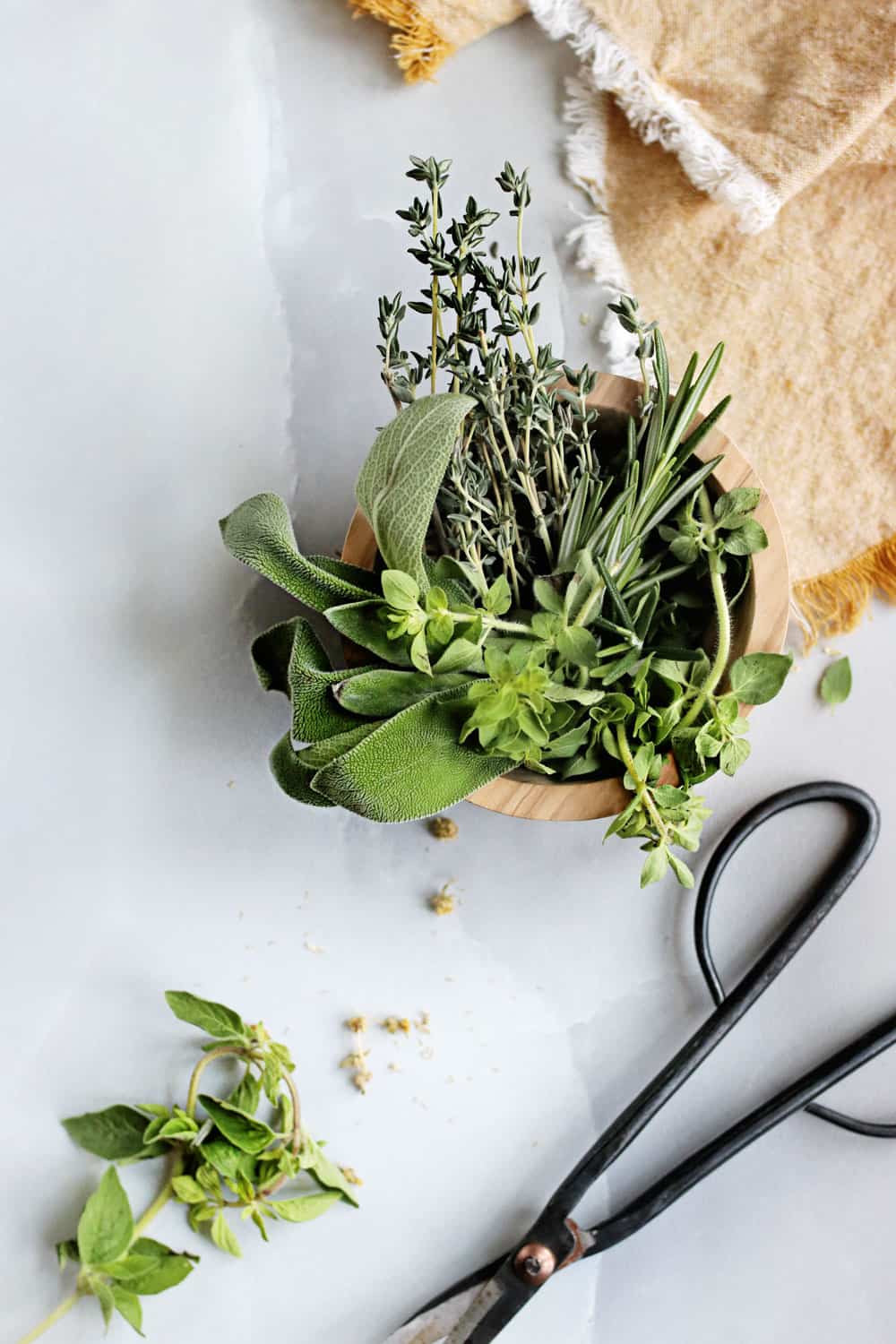
Water: makes up the base of your rinse, and it’s usually boiled.
Herbs: depends on your hair type and needs:
- Dry hair: chamomile, lavender, or calendula
- Oily hair: rosemary, nettle, or peppermint
- Enhancing growth: horsetail, rosemary, or ginseng
- General hair health: green tea, basil, or hibiscus
Equipment
- Pot for boiling water
- Strainer or cheesecloth
- Bottle or jar for storage
Instructions
Choose your herbs: Pick the herbs that suit your hair type or address specific issues like dryness, oiliness, growth, or scalp health.
Boil water: Bring about 1–2 cups of water to a boil.
Steep herbs: Add a handful of your chosen herbs to the boiling water. Turn off the heat and let the herbs steep for at least 20–30 minutes. The longer they steep, the stronger the infusion will be.
Strain: Use a strainer or cheesecloth to remove the herbs, collecting the liquid in a squeeze bottle or cup.
Cool down: Allow the herbal infusion to cool completely.
Use: After shampooing and conditioning, pour the herbal rinse over your hair as a final rinse. You can choose to leave it in your hair or rinse it out with cool water after a few minutes.
Herbal Rinse Variations
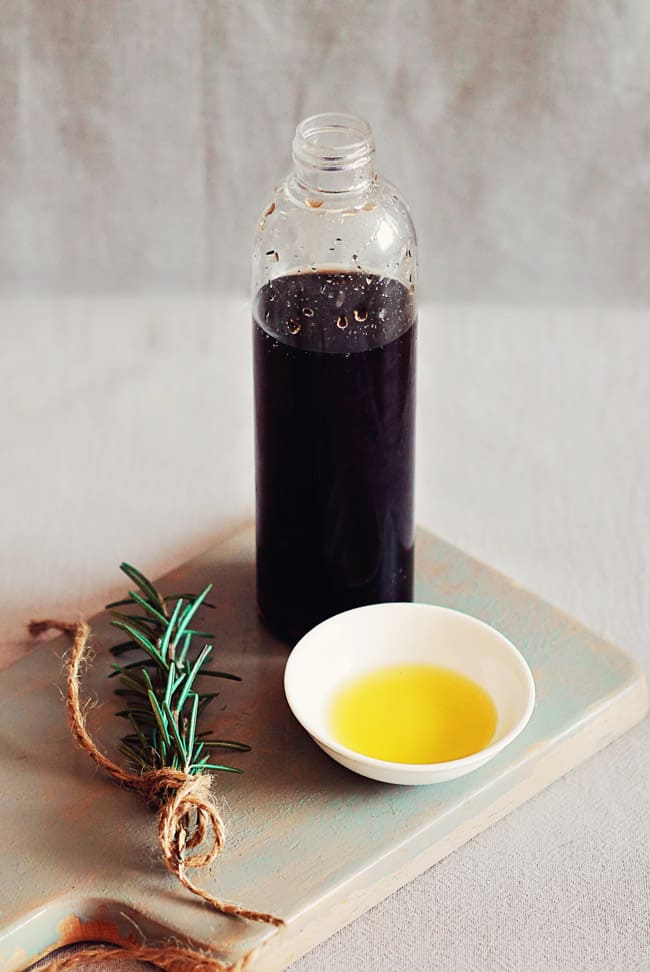
Varying a natural hair rinse recipe can be quite fun and allows you to tailor it specifically to your hair's needs or to the ingredients you have on hand.
1. Change the Base Liquid:
- Tea: Instead of water, use green tea, black tea, or herbal tea as the liquid base. These can add additional nutrients and antioxidants [source] to the rinse.
- Vinegar: A base of diluted apple cider vinegar helps to restore pH balance and add shine. It can be especially beneficial for oily or dull hair.
- Beer: The yeast in a strong stout beer (like Guinness) plumps up the hair shaft, while the hops and malt are said to nourish and stimulate the hair shaft. Let the bottle sit open overnight or longer because you want the beer to be flat.
2. Mix Multiple Herbs:
- Combination brews: Combine herbs that complement each other’s effects. For example, rosemary and peppermint can stimulate scalp circulation, while chamomile and lavender can soothe and soften.
- Seasonal herbs: Utilize seasonal herbs or those that are freshly available in your area for added potency.
3. Infuse with Flowers:
- Floral infusions: Add flowers like roses, jasmine, or hibiscus to the rinse. These not only add a beautiful fragrance but they can also have benefits for the hair. Hibiscus, for instance, is known for promoting hair growth, particularly the leaves [source], and adding a vibrant sheen.
4. Incorporate Essential Oils:
- Customize with oils: Depending on your hair’s needs, add a few drops of hair essential oils to the cooled rinse. For example:
- Tea tree oil for scalp health and to combat dandruff [source]
- Lavender oil for calming and anti-inflammatory [source] properties
- Peppermint oil to stimulate the scalp [source] and add a refreshing scent
5. Add Fruit Juices:
- Citrus boost: Squeeze in some lemon, lime, or orange juice to help strip away residue from hair products and leave your hair shiny. These are natural astringents that can help manage oily hair.
6. Include Natural Oils:
- Moisturize: For an extra moisturizing effect, especially for dry hair, you can add a small amount of coconut oil, jojoba oil, or argan oil [source] to the rinse. Ensure this is well mixed, and use sparingly, as oils can weigh down your hair if used excessively.
7. Utilize Aloe Vera:
- Soothing gel: Include fresh aloe vera gel in your rinse for its soothing and moisturizing properties. It’s great for scalp health and can help with irritation or dryness.
8. Experiment with Ferments:
- Fermented rice water: Use fermented rice water as a hair rinse base for its rich vitamin and mineral content [source], which is believed to strengthen hair and add shine.
9. Cold Brew Technique:
- No heat steeping: Instead of boiling the herbs, you can steep them in cold water overnight. This method is believed to preserve more of the herbs’ beneficial properties and is gentler on some of the more delicate ingredients.
Natural Hair Rinse Recipes for Every Hair Type
Creating an herbal hair rinse tailored to different hair types can help address specific haircare needs effectively. Here are some customized recipes for various hair types:
1. For Dry or Damaged Hair

A dry hair rinse with chamomile, marshmallow root, and lavender in a coconut milk base provides intense moisture and soothes the scalp. These ingredients are known for their hydrating properties and help to soften and repair dry, brittle hair.
Ingredients
- Herbs: chamomile, marshmallow root, and lavender
- Base: coconut milk (for its moisturizing properties)
- Essential oils: a few drops of lavender or sandalwood
Instructions
- Boil water, add the herbs, and let them steep for 30 minutes.
- Strain and mix the liquid with coconut milk. Add your essential oils when the mixture is cool.
- After shampooing, bend forward and pour the mixture over your hair. Let it sit on the hair for several minutes, massaging it into the roots. Rinse and style as usual.
2. For Oily Hair
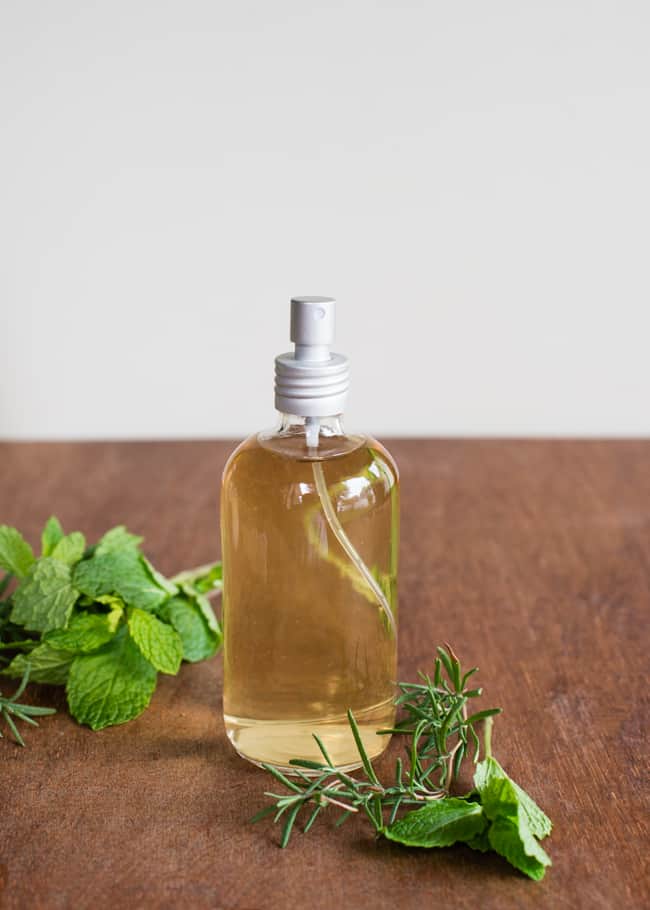
Rosemary, nettle, and peppermint are excellent for managing oil production; their astringent properties help reduce excess sebum on the scalp. Green tea acts as a base that may further help to tighten pores and balance oil levels.
- Herbs: rosemary, nettle, and peppermint
- Base: green tea (for its astringent properties)
- Essential oils: a few drops of peppermint or lemon
Instructions
- Steep the herbs in freshly made green tea for 20–30 minutes. Strain and cool the infusion, then add essential oils.
- After shampooing, pour over wet hair (or spray directly onto the scalp) and brush through from scalp to ends.
- Let it sit for 15 minutes, then rinse with cool water. Use twice a week.
3. For Hair Growth
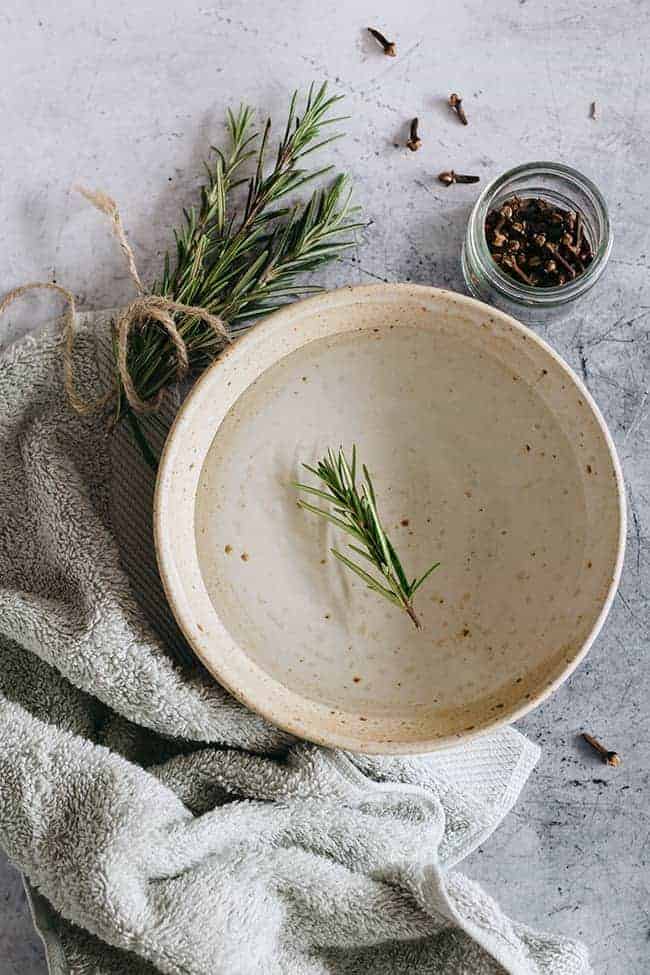
Combine rosemary, horsetail, and ginseng in a hair rinse that stimulates the scalp and promotes blood circulation. Rosemary, in particular, is well-known for its ability to boost hair thickness and growth [source].
This anti-inflammatory and antimicrobial hair tonic is an easy and cost-effective way to add rosemary to your haircare routine. It’s the perfect spritz-and-go solution for thinning hair.
Ingredients
- Herbs: rosemary, horsetail, and ginseng
- Base: water
- Essential oils: a few drops of rosemary or cedarwood
Instructions
- Boil water, add herbs, and allow the mixture to steep until it cools. Strain and add your essential oils to the infusion.
- Pour the liquid into a spray bottle. After shampooing, spritz the water onto your towel-dried hair, and massage it into the scalp and strands. Dry your hair and style it as usual.
- You can also spray it onto your hair before bed to leave it on overnight. Repeat twice a week.
4. For Shiny Hair
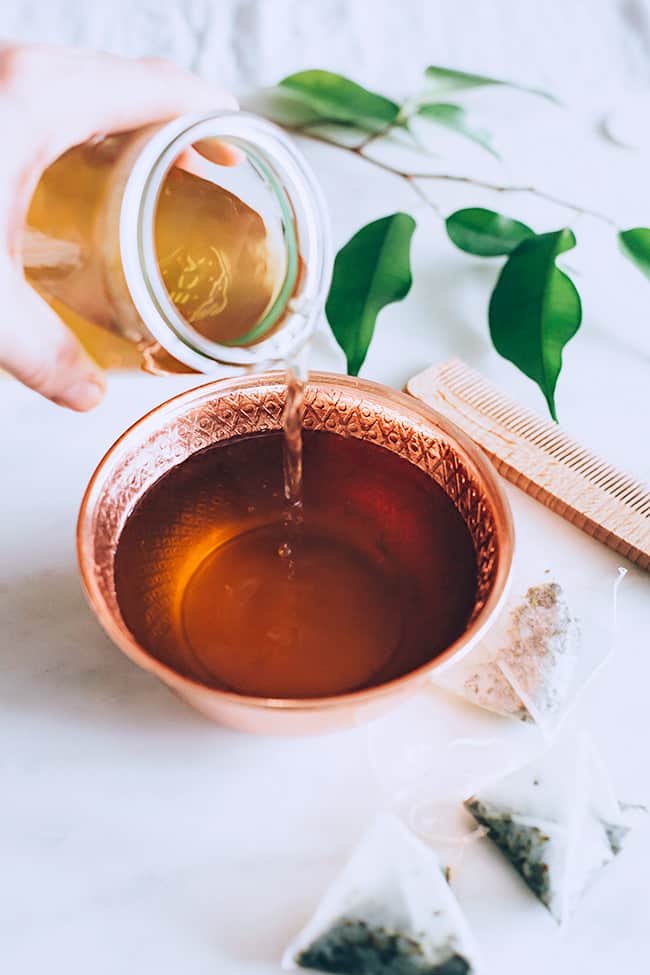
For shiny, glossy hair, an herbal hair rinse can be an excellent natural remedy to enhance the luster of your hair by smoothing the cuticles and removing residue. Green tea and basil gently cleanse the scalp without stripping away essential oils, making them ideal for use on normal hair.
The caffeine, antioxidants, and catechins found in green tea [source] encourage blood flow and circulation to hair follicles, reduce inflammation, and ease dandruff. Incorporating green tea into a hair rinse or mask and using it weekly will not only stimulate growth but will even encourage healthier, shinier tresses.
Ingredients
- Herbs: green tea and basil
- Base: water
- Essential oils: a few drops of ylang-ylang or geranium
Instructions
- Prepare a green tea infusion, add basil while it’s hot, and allow it to steep for 20 minutes.
- Strain out the herbs, cool the mixture, and add your essential oil.
- Once you’ve shampooed and conditioned your hair, use the cooled green tea/herb infusion as your final rinse.
- Massage the liquid into the scalp to help diminish dandruff, stimulate follicles, and make your hair shine.
5. For Dandruff or Scalp Issues

Tea tree, neem, and thyme are known to have strong antibacterial and antifungal properties, addressing the root causes of dandruff and scalp irritation. An apple cider vinegar hair rinse helps to restore pH balance and gets rid of the gunky buildup that weighs down hair.
Ingredients
- Herbs: neem and thyme
- Base: raw, organic apple cider vinegar (use 1 part ACV with 2 parts water)
- Essential oils: a few drops of tea tree or neem
Instructions
- Boil water and steep the herbs for 30 minutes.
- Strain out the herbs, and mix the infusion with equal parts of diluted apple cider vinegar. Add your essential oil when cool.
- After shampooing, slowly pour the herb scalp rinse over freshly washed hair while standing in the shower. Focus on small sections of the scalp with each pour.
- Comb through with a wide-tooth comb to evenly distribute the liquid, then let it sit for 5 minutes. Rinse well.
6. For Color-Treated Hair

Herbs and teas are gentle on chemically treated hair and can enhance color vibrancy. We like hibiscus for red tones, black tea for dark hair, and chamomile for lighter tones.
These herbs also nourish the hair and help retain moisture—essential for color-treated hair that is often prone to dryness.
Ingredients
- Herbs: hibiscus (to enhance red tones), organic black tea (for dark tones), or chamomile (for lighter tones)
- Base: water
- Essential oils: a few drops of lavender (for its soothing properties)
Instructions
- Boil water, add the selected herbs, and let them steep until the color of the water deepens.
- Strain out the herbs, cool the infusion, and then add essential oil.
- Cool completely and pour the glossy hair rinse over your hair.
- Let sit for 10 minutes, then rinse. Repeat weekly.
7. For Thicker Hair
For thinning hair, using an herbal rinse can be beneficial for stimulating the scalp and promoting hair growth. Here’s a recipe that focuses on herbs known for their efficacy in enhancing hair thickness and health:
Ingredients
- Herbs: rosemary, nettle, peppermint, horsetail
- Base: green tea and raw, organic apple cider vinegar
- Essential oils: rosemary or lavender
Instructions
- Steep 1 tablespoon each of dried rosemary, nettle, peppermint, and horsetail in 4 cups of boiling water.
- Add 1–2 green tea bags when the water cools slightly.
- Strain out the herbs and add ¼ cup apple cider vinegar and essential oils after cooling.
- Use this infusion as a final rinse after shampooing and conditioning your hair. Pour it slowly over your scalp and hair, massaging gently to ensure it covers all areas.
Usage
Always let the herbal rinse cool to a comfortable temperature before applying it to your scalp.
Apply the infusion to your hair after shampooing and conditioning.
- A squeeze bottle makes applying a DIY hair rinse much easier, plus you can target specific areas of your scalp.
- If you’re using a bottle or cup, then bend over and let your hair hang upside down as you pour the rinse.
Use these rinses once a week or as part of a bi-weekly haircare regimen, depending on your hair’s needs and response.
You can make these rinses in batches and store them in the refrigerator for up to a week. Always shake well before use.
FAQ
Select herbs based on your hair and scalp needs. For oily hair, look for astringent herbs like nettle or rosemary. For dry hair, moisturizing herbs like marshmallow root or lavender are beneficial. Research the properties of different herbs to find the best match for your particular haircare needs.
It depends on the ingredients and your personal preference. Some rinses, especially those made with vinegar or strong-smelling herbs, might be better rinsed out to avoid lingering odors. Others, like those made with gentle teas or oils, can be left in to act as a leave-in conditioner.
After shampooing and conditioning, pour the rinse slowly over your scalp and hair, massaging gently. You can catch the runoff in a bowl and reapply it several times. Rinse out or leave in as desired based on your hair type and the ingredients used.
References
References
Khan N, et al. Tea polyphenols in promotion of human health. Nutrients. 2019.
Rose LC, et al. Potential hair growth of crude extract from Hibiscus rosa-sinensis Linn. Arch Pharma Pract. 2020.
Jain S, et al. Essential oils as potential source of anti-dandruff agents: a review. Comb Chem High Throughput Screen. 2022.
Esteves Cardia GF, et al. Effect of lavender (Lavandula angustifolia) essential oil on acute inflammatory response. Evid Based Complementary Altern Med. 2018.
Zhao H, et al. Peppermint essential oil: its phytochemistry, biological activity, pharmacological effect and application. Biomed Pharmacother. 2022.
Lin TK, et al. Anti-inflammatory and skin barrier repair effects of topical application of some plant oils. Int J Mol Sci. 2017.
Shano HF, et al. Nutritional analysis and antimicrobial activity of fermented rice water. Der Pharma Chemica. 2021.
Ezekwe N, et al. The use of natural ingredients in the treatment of alopecias with an emphasis on central centrifugal cicatricial alopecia: a systematic review. J Clin Aesthet Dermatol. 2020.Farhan M. Green tea catechins: nature’s way of preventing and treating cancer. Int J Mol Sci. 2022.



